Poster: Interventional & RF: Safety & Solutions
Electronic Power Pitch Poster
MR Safety
09:15 - 10:15
Wednesday, 20 June 2018
Power Pitch Theater A - Exhibition Hall
| |
|
Plasma # |
|
0638.
 |
1 |
 Reducing Radiofrequency-induced Heating in Realistic Deep Brain Stimulation Lead Trajectories using Parallel Transmission Reducing Radiofrequency-induced Heating in Realistic Deep Brain Stimulation Lead Trajectories using Parallel Transmission
Pei-Shan Wei, Benson Yang, Clare E. McElcheran, Laleh Golestanirad, Simon J. Graham
Patients with deep brain stimulation devices have a safety concern for localized heating that can arise during MRI. Clinically, the lead trajectory for the surgical stimulation procedure varies among patient population. We have shown in previous numerical simulations that the lead trajectory would affect the performance of heating suppression in patient-specific pTx optimization. The present work experimentally validated that RF-induced heating can be suppressed for a high-risk patient-specific lead trajectory, using optimal pTx input parameters.
|
|
0639.
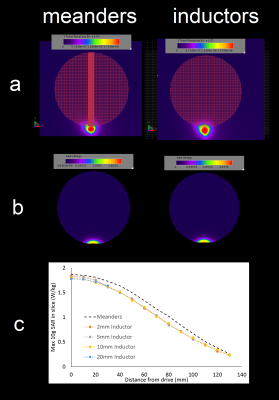 |
2 |
 Electrical lengthening to improve electromagnetic simulations and SAR calculations of meandered body dipole elements at 7T Electrical lengthening to improve electromagnetic simulations and SAR calculations of meandered body dipole elements at 7T
Stephen Bawden, Richard Bowtell, Penny Gowland, Paul Glover
This study investigated the use of electrical-lengthening as an alternative method of simulating meandered dipole arrays. Dipoles were compared with (a) differing inductor positions, (b) rotating dipole along main axis and (c) for multiple dipole transmission. Results showed a simple single wire dipole model with electrical-lengthening produced comparable SAR solutions, were less effected by rotations and cut simulation times by up to 10 times.
|
 |
0640.
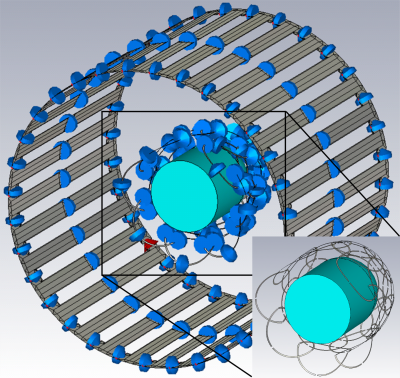 |
3 |
 SAR Calculations in Transmit-Only-Receive-Only RF systems: A Comparison of Detuning Methods for Rx Array Coils and their Implementation in EM Simulations SAR Calculations in Transmit-Only-Receive-Only RF systems: A Comparison of Detuning Methods for Rx Array Coils and their Implementation in EM Simulations
Matthias Malzacher, Jorge Chacon-Caldera, Mathias Davids, Lothar Schad
The accurate simulation of SAR is important to guarantee patient safety in MRI measurements especially for local variations. Although most clinical RF systems are hybrid systems (separate Transmit (Tx) and Receive (Rx) coils), the effect of the Rx coils on Tx power consumption, B1+-homogeneity and SAR have been seldom investigated. Rx coils present highly conductive surfaces which affect the RF field distribution. In this work, we evaluate the performance of several detuning concepts and their realization in the EM simulations concerning Tx power consumption, B1+-homogeneity and SAR for a hybrid setup at 3T.
|
 |
0641.
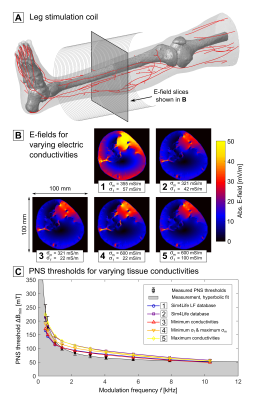 |
4 |
 Sensitivity analysis of Peripheral Nerve Stimulation modeling: Which model parameters actually matter? Sensitivity analysis of Peripheral Nerve Stimulation modeling: Which model parameters actually matter?
Valerie Klein, Mathias Davids, Bastien Guérin, Lothar Schad, Lawrence Wald
Peripheral nerve stimulation (PNS) has become the main limitation for MRI with high-performance gradients. Recently, we proposed a simulation framework to predict PNS thresholds for arbitrary coil geometries to directly address PNS considerations during the coil prototyping phase. In order to ensure robust modeling of PNS (and thus convergence of the coil optimization phase), we analyze the sensitivity of our framework to key simulation parameters such as the temporal and spatial resolution of the induced electric fields, dielectric tissue parameters of our body models, and the location of the neurodynamic model compartments along the nerve fibers.
|
 |
0642.
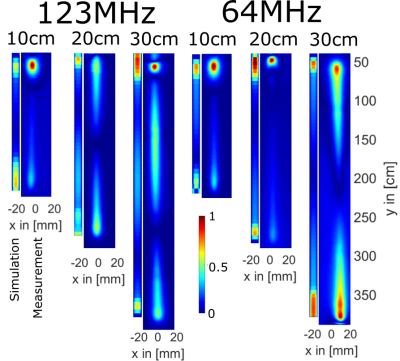 |
5 |
 Validating and Measuring Transfer Functions of Straight Wires using a Combination of an Electro-optic Field Sensor and Simulation Validating and Measuring Transfer Functions of Straight Wires using a Combination of an Electro-optic Field Sensor and Simulation
Thomas Lottner, Simon Reiss, Ali Özen, Michael Bock, Andreas Bitzer
To investigate deep brain stimulators, pacemakers or other elongated structures the transfer function was proposed to characterize these devices. A electro-optic E-field sensor is used to acquire 2D field data of copper wires excited at one tip for 64 and 123MHz. The data is compared to simulations and transfer functions are calculated from these simulations. These are compared to experimentally acquired transfer functions.
|
|
0643.
 |
6 |
 Imaging Conditions and Image Quality for Patients with MR-conditional Implantable Medical Devices: Normal Volunteer Study Imaging Conditions and Image Quality for Patients with MR-conditional Implantable Medical Devices: Normal Volunteer Study
Kagayaki Kuroda, Saeko Sunohara, Satoshi Yatsushiro, Toshiki Saito, Nao Kajiwara, Tomohiko Horie, Toshiki Kazama, Tetsu Niwa, Yutaka Imai
Actual SAR values measured by calorimetry varied for a factor of 2.3 among three different scanners (two 1.5T and one 3T) even at identical console SAR settings. Console B1+RMS values also deviate for a factor of 1.2 between the two 1.5T. Image quality assessment performed by three radiologists suggested that the image quality change due to the console SAR setting was not critical at a 1.5-T scanner, but was so at a 3-T scanner. Therefore attention should be paid to the variation of the actual SAR even if the console SAR is at a condition specified for an implantable medical device.
|
 |
0644.
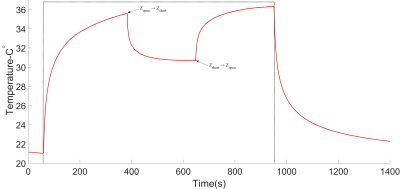 |
7 |
 Wireless MR-Compatibility Control of Active Implantable Medical Devices Wireless MR-Compatibility Control of Active Implantable Medical Devices
Berk Silemek, Volkan Açikel, Ugur Yilmaz, Ergin Atalar
In this study, we proposed a prototype implant that can be controlled wirelessly to change the connection impedance between the lead and the case. To show the effect of the connection impedance between the lead and the case, the tip temperature increase was calculated for 3 different lead lengths by placing a capacitance between the lead and the case. Two different case to lead connection impedance values were switched in this work as proof of a concept and tip temperature heating was changed during the scanning. It is demonstrated that by changing the impedance, the lead tip heating properties can be changed allowing safe scanning. it can be useful for avoiding excessive heating if resonance condition occurs due to environmental factors inside human body and position inside the scanner.
|
|
0645.
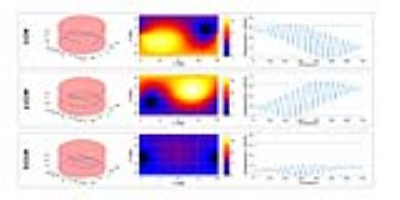 |
8 |
 Experimental implementation of test-field diversity method for RF-induced heating assessment of medical implants Experimental implementation of test-field diversity method for RF-induced heating assessment of medical implants
Earl Zastrow, Aiping Yao, Niels Kuster
We summarize the experimental implementation of test-field diversity (TFD) method for radiated immunity testing of medical implants. The TFD method is used to provide a diverse and well-characterized incident conditions to the implant during radiated immunity test. As an illustrative example, the TFD is used for in vitro validation of a Tier 3 model that describes RF-induced heating of a commercial medical implant at 64 MHz. Results shown a dynamic range of 10 dB for the tip deposited power can be obtained experimentally. The experimental instrumentation and the practical considerations of the method are discussed.
|
|
0646.
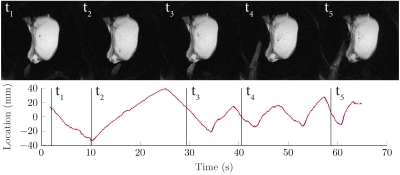 |
9 |
 SMART tracking: SiMultaneous Anatomical imaging and Real-Time needle tracking SMART tracking: SiMultaneous Anatomical imaging and Real-Time needle tracking
Frank Zijlstra, Peter Seevinck
We propose a passive needle tracking method for MR-guided interventions. We combined undersampled 2D radial multi-echo acquisitions, the white marker phenomenon, and simulations and template matching of artifacts around the needle tip to achieve real-time (10 Hz) tracking of the needle tip, while simultaneously being able to reconstruct anatomical images using a sliding window reconstruction. The method is demonstrated to smoothly track the insertion of a needle in porcine tissue while also showing deformations in the anatomical image caused by the needle insertion. These results bridge a gap between active and passive tracking of needles.
|
|
0647.
 |
10 |
 MRI Safety Assessment of Orthopedic Implants on the Bone Surface via the Induced Tangential E-Fields MRI Safety Assessment of Orthopedic Implants on the Bone Surface via the Induced Tangential E-Fields
Manuel Murbach, Earl Zastrow, Esra Neufeld, Theodoros Samaras, Wolfgang Kainz, Niels Kuster
Orthopedic implant manufacturers produce a large portfolio of on-bone devices. Current implant RF safety standards, e.g., ASTM F2182-11a and TS/ISO 10974, do not take advantage of very well-defined data on relevant RF exposures of these devices, i.e., E-fields tangential to the bone-surface. In our approach presented here, we explore the use of the bone-surface-averaged tangential E-field as a close approximation of the incident field impacting an on-bone orthopedic device. The relevant surface-averaged tangential E-fields are less than half of the corresponding peak volume-averaged E-fields, which allows for realistic but not overly conservative assessment of RF implant safety in MRI.
|
|
0648.
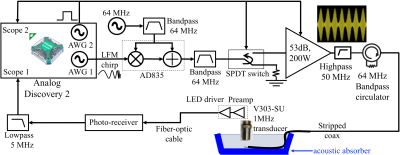 |
11 |
 A Reproducible and Lower-Cost Thermo-Acoustic Ultrasound System for Detection of RF-Induced Lead Tip Heating in MRI A Reproducible and Lower-Cost Thermo-Acoustic Ultrasound System for Detection of RF-Induced Lead Tip Heating in MRI
Neerav Dixit, Pascal Stang, John Pauly, Greig Scott
Thermo-acoustic ultrasound (TAUS) has been shown to be able to detect the peaks in local SAR indicative of RF-induced lead tip heating in an MRI setting. Here, we detail a reproducible TAUS acquisition system consisting entirely of commercially accessible electronics that can interface with an MRI scanner. This system achieves comparable performance to our previously demonstrated acquisition system with lower cost electronics, while also providing additional functionality that could aid in the development of a robust TAUS pre-scan to assess the risk of RF-induced lead tip heating in MRI.
|
|
0649.
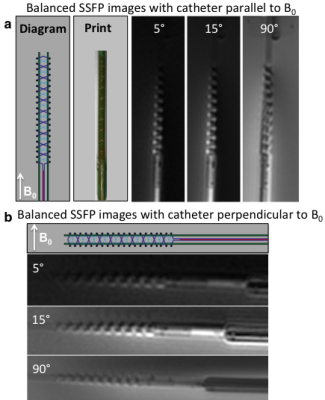 |
12 |
 An Aerosol-Deposited Wireless Resonant Marker for Catheter Tracking in Interventional MRI An Aerosol-Deposited Wireless Resonant Marker for Catheter Tracking in Interventional MRI
Caroline Jordan, Bradford Thorne, Arjun Wadhwa, Vincent Fratello, Alastair Martin, Xiaoliang Zhang, Steven Hetts
Catheter visualization and guidance under MRI guidance can be challenging, and conventional MR tracking coils decrease the flexibility and increase the profile of catheters. We used aerosol jet deposition to print a capacitor and an inductor with a double helix geometry on a polymer catheter. bSSFP sequences with flip angles 5°, 15°, and 90°, and a B1+ map were acquired at 3T, and CNR and amplification were measured. The marker demonstrated good CNR and B1+ signal amplification, suggesting that fabrication of complete 3D printed LC circuits for use as markers on catheters is feasible and can exhibit good tracking characteristics.
|
|
0650.
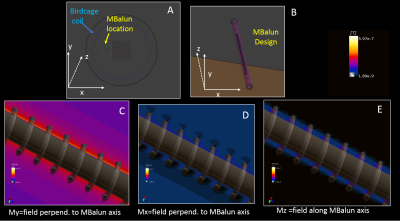 |
13 |
 Actively-tracked metallic electrophysiology catheters and guidewires with miniature floating radio-frequency traps: Theory, Design and Validation Actively-tracked metallic electrophysiology catheters and guidewires with miniature floating radio-frequency traps: Theory, Design and Validation
Ehud Schmidt, Eric Meyer, Ronald Watkins, Hassan Elahi, Wolfgang Loew, Jeffrey Schweitzer, Gregory Olson, Aravindan Kolandaivelu, Henry Halperin
Metal-reinforced catheters have improved steerability and pushability. Currently, long (>wavelength/8) metallic-braided or metallic-tube-reinforced active MRI-compatible devices do not exist, due to risks of heating of surrounding tissue. Metallic-backbone devices may be possible if heating-sources are attenuated. Concentric-tube RF traps were miniaturized (“MBaluns)” by using leaky (loosely-wound) solenoids in-place of the external tube, providing transverse magnetic fields to attenuate (a) surface electric-fields on metals and (b) common-mode propagation on internal-cables. We validated (1) a 1.1mm outer-diameter (OD) active metallic-tube-based guidewire and (2) a 2.6mm OD metallic-braid-based electrophysiology catheter via; Electromagnetic modeling, Network-Analyzer electrical tests, phantom imaging and navigation into swine hearts.
|
|
0651.
 |
14 |
 AN ACTIVE BIOPSY NEEDLE DESIGN FOR MRI GUIDED PROSTATE BIOPSY AN ACTIVE BIOPSY NEEDLE DESIGN FOR MRI GUIDED PROSTATE BIOPSY
Korel YILDIRIM, Ibrahim MAHCICEK, Ozgur KOCATURK
In this work, we present a novel low profile and active biopsy needle for MRI guided prostate interventions. We show that using conductive ink printed non-planar RF antenna components does not compromise overall device profile while maintaining required mechanical properties for clinical grade devices. We confirmed that the biopsy needle design is conspicious under MRI while maintaining RF induced heating below the allowed limits. This work demonstrates the feasibility of developing ultra low profile active interventional devices and potentially enables physicians to perform MRI guided prostate interventions.
|
 |
0652.
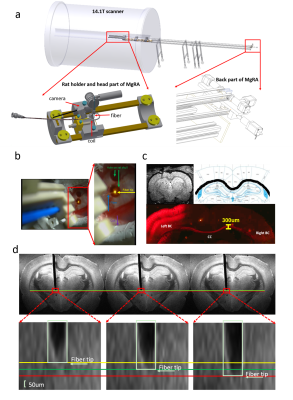 |
15 |
 MRI-guided robotic arm (MgRA) drives optogenetic activation of the rat corpus callosum MRI-guided robotic arm (MgRA) drives optogenetic activation of the rat corpus callosum
Yi Chen, Pais Patricia, Xuming Chen, Xin Yu
An MRI-compatible robotic arm was developed to provide a precise fiber positioning for optogenetic fMRI of the rat brain. Corpus callosum connects two hemispheres through a thin sheet of spreading fiber bundle with only a few hundred micron thickness in the brain. This work shows that MgRA can guide fiber optic to precisely target the callosal fiber bundles. The optogenetically driven callosal axonal fiber-mediated neural activity leads to strong antidromic activation in the hemisphere with callosal neurons expressing ChR2 by fMRI.
|
|

 Watch the full Pitch Session Here
Watch the full Pitch Session Here















